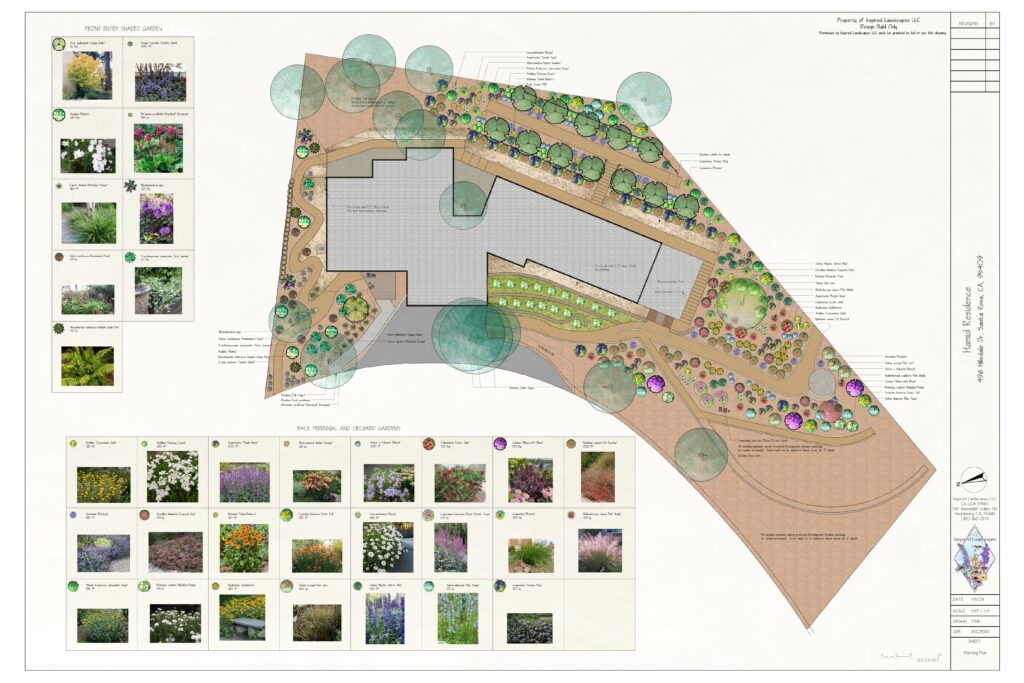
What Should I Expect From a Landscape Designer?
Hiring your landscape designer is a critical step in ensuring your landscape design project is a resounding success. However, in Sonoma County, there are so many options to choose from with an incredibly wide range of quality, expertise, and levels of service. Landscape Designers in Healdsburg come in all shapes and sizes, from hobbyist gardeners with some artistic skill seeking fun projects to seasoned professionals using computer-based design programs.
Not everyone needs the most detailed or complicated plan sets to accomplish their goals of a planting expansion, while others need fully formed plan sets for ground-up construction. If you are looking for Landscape Designers near me in Healdsburg then use this guide to learn not only what to expect, but also, what you should look for in a landscape designer.
Does your designer have a background in construction or working in the field?
While cliche, ‘The School of Hard Knocks’ rings true through all the trades as one of the greatest sources of practical knowledge in the field of work one specializes in. Commonly, designers won’t have any experience building landscapes themselves. While this may not be a dealbreaker, it limits how much they understand the ins and outs of the construction process.
This can lead to sticky moments when you go to hire a contractor because suddenly you find out your beautiful drawing can’t be built because of issues with utilities supply line locations, elevations, or other practical “on the ground” situations that weren’t considered. Another drawback is that a designer without field experience might create drawings that are beautiful, but incredibly complex and expensive to build. Without experience actually in the field completing construction projects themselves, it’s easy to overlook these details leaving a client holding the bag and ending up frustrated that their budget has skyrocketed.
Interview your designer and ask them about their past experiences in landscaping. Do they have a background in landscape maintenance which will allow them to understand exactly what type of maintenance program their design will require to upkeep? Do they have experience building irrigation and lighting systems so that they understand the advantages and limitations of certain equipment they have specified? Have they ever actually built a project hands-on from start to finish so that their experience can guide design choices they make in order to save you money and create a design that is practical to build? All of these are critical questions to understand if your landscape designer is fit for your project.

The advantages of computer aided design (CAD) vs. hand drafting
Traditionally landscape designers drafted by hand, and many still do. A respectable skill no doubt, hand drafting has many disadvantages for a client as it is cumbersome, slow, limited in presentation options, and more challenging to revise.
When hand drafting you are relying literally on paper and pencil that needs to be erased or redrawn from scratch whenever you want to make a revision. We’ve often seen plans come in from architects that are nearly illegible because there are so many erasure marks and cross outs. As designers charge high hourly rates it’s essential that you’re not paying someone to erase or redrawn lines from scratch. On a computer aided design (CAD) making edits is incredibly simple and quick with a few clicks of a mouse, better yet, the original drafts can be saved as separate files and remain unchanged in case you want to take a couple of steps back to remember what you had in previous versions. This flexibility will save you tons of money and frustrating digging through stacks of papers or trying to read scruffy handwriting.
There are many advanced tools with CAD that allow for very precise measurements and labeling of dimensions that prove very useful in the bidding process as well. This means saving money on collecting bids, but also being confident that the bids you receive are accurate because they are measured from a plan that is thoroughly and clearly labeled. CAD based drawings can also incorporate photos, and 3D imaging to accompany the landscape plan which illustrate design concepts with far more depth than hand drawing can.
Lastly, there is an ease of use and integration with digital files that streamlines a landscape project and file management. All your files can easily be printed and copied without needing to go to an expensive print shop and deal with wait times for it to be processed. Also, all CAD based software uses a file type called ‘.dwg’ that can be shared between your landscape designer, structural architect, or other designers on the project that allow them to use your landscape designer’s drawings to create drawings of their own. Again, saving you a hefty sum of money rather than having everyone need to start from scratch.

The importance of horticultural expertise in a landscape designer
Surprisingly many landscape designers and architects have very limited horticultural experience and instead have focused their study on structural elements like hardscapes, retaining walls, or pergolas. While having a broad range of knowledge on these topics is essential, it completely overlooks how horticultural expertise brings an immense value to your project. Recommendations such as plant selection and soil amendment techniques are core to the success and aesthetic of the project.
For example, say you were hoping to incorporate native plants, create a desert garden, or are looking for an English cottage-style garden, these are all vastly different horticultural approaches. Not only are the plants completely different, but the soil preparation and irrigation vary dramatically. Additionally, understanding how these very different horticultural aesthetics perform in your specific area is essential. Planting native is always an admirable choice, however, some native plants perform very poorly in a landscape environment and aren’t well suited for home gardens as they have long dormancy periods in summer, or simply can’t stand being transplanted. Desert gardens can work well in Healdsburg and Sonoma County, however many plants that are considered ‘desert’ plants, such as certain types of Aloe, can’t stand the cold and often freeze in our cold winters. English cottage gardens employ a wide range of flowering plants that can be just as fussy are they are beautiful. Having a landscape designer with a deep horticultural knowledge based on local plant knowledge and management of local landscapes is an absolutely priceless attribute to ensure your landscape is not only beautiful, but actually thrives.
Our design team at Inspired Landscapes is uniquely suited for all types of landscape design projects in Healdsburg and Sonoma County. Lead designer, Matt Ripley, has over a decade of field experience constructing landscapes of all shapes and sizes from small planter beds to multi-acre estates. With nearly 10 years of experience in computer aided design, he has perfected the process of creating artistic representations of the landscape that are easy for anyone to digest and get a clear sense of what they will be building. Matt’s entire life has been dedicated to horticulture in Sonoma and Marin county through personal gardens at home and management of hundred, perhaps over thousand different landscapes throughout his career, meaning his knowledge of plants both native and exotic is highly developed and can therefore guide you in designing a wide breadth of aesthetics and stylistic choices rooted in what works and how to make your plant selections thrive in your specific environmental conditions.
Give us a call today for a free consultation! (707) 395-7474





